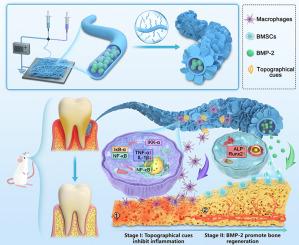分层结构纳米纤维支架在时空上调解骨免疫微环境,促进牙周炎相关牙槽骨再生的成骨过程。
IF 9.4
1区 医学
Q1 ENGINEERING, BIOMEDICAL
引用次数: 0
摘要
牙周炎是由炎症引起的牙周组织破坏,导致牙槽骨严重缺损。控制炎症和促进骨再生是治疗牙周炎相关牙槽骨缺损的两个关键环节。在此,我们开发了一种分层结构的纳米纤维支架,它具有纳米浮雕鞘和骨形态发生蛋白 2 负载核心,符合牙周炎的特异性特征,可在时空上调节骨免疫环境并促进牙周骨再生。我们研究了这种独特支架在体内和体外治疗牙周炎相关牙槽骨缺损的潜力。结果表明,分层结构支架有效降低了巨噬细胞的炎症水平,增强了骨间充质干细胞在炎症微环境中的成骨潜能。此外,体内实验显示,分层结构支架能显著改善牙周炎症,抑制牙槽骨吸收。值得注意的是,分层结构支架在促进牙槽骨再生方面也表现出了长效作用。这些发现凸显了分层结构纳米纤维支架在治疗牙周炎方面的巨大潜力,以及其在牙周组织再生领域的广阔前景。意义声明:我们展示了一种新型分层结构纳米纤维支架,它能将拓扑学和生物分子信号耦合起来,对骨免疫微环境进行精确的时空调节。具体来说,该支架是通过同轴电纺聚(ε-己内酯)鞘和BMP-2/聚乙烯醇核心,然后通过表面定向外延结晶在鞘上产生环状纳米层状压花而设计的。通过这种独特的分层结构,环状纳米胶束鞘为缓解骨免疫环境提供了直接的纳米地形线索,而从核心逐步释放的 BMP-2 则为骨再生提供了生物线索。这项研究强调了分层结构纳米纤维支架作为牙周组织再生治疗方法的潜力,并突出了其在推进牙周组织工程中的作用。本文章由计算机程序翻译,如有差异,请以英文原文为准。

Hierarchically structured nanofibrous scaffolds spatiotemporally mediate the osteoimmune micro-environment and promote osteogenesis for periodontitis-related alveolar bone regeneration
Periodontitis suffer from inflammation-induced destruction of periodontal tissues, resulting in the serious loss of alveolar bone. Controlling inflammation and promoting bone regeneration are two crucial aspects for periodontitis-related alveolar bone defect treatment. Herein, we developed a hierarchically structured nanofibrous scaffold with a nano-embossed sheath and a bone morphogenetic protein 2-loaded core to match the periodontitis-specific features that spatiotemporally modulated the osteoimmune environment and promoted periodontal bone regeneration. We investigated the potential of this unique scaffold to treat periodontitis-related alveolar bone defects in vivo and in vitro. The results demonstrated that the hierarchically structured scaffold effectively reduced the inflammatory levels in macrophages and enhanced the osteogenic potential of bone mesenchymal stem cells in an inflammatory microenvironment. Moreover, in vivo experiments revealed that the hierarchically structured scaffold significantly ameliorated inflammation in the periodontium and inhibited alveolar bone resorption. Notably, the hierarchically structured scaffold also exhibited a prolonged effect on promoting alveolar bone regeneration. These findings highlight the significant therapeutic potential of hierarchically structured nanofibrous scaffolds for the treatment of periodontitis, and their promising role in the field of periodontal tissue regeneration.
Statement of significance
We present a novel hierarchically structured nanofibrous scaffold of coupling topological and biomolecular signals for precise spatiotemporal modulation of the osteoimmune micro-environment. Specifically, the scaffold was engineered via coaxial electrospinning of the poly(ε-caprolactone) sheath and a BMP-2/polyvinyl alcohol core, followed by surface-directed epitaxial crystallization to generate cyclic nano-lamellar embossment on the sheath. With this unique hierarchical structure, the cyclic nano-lamellar sheath provided a direct nano-topographical cue to alleviate the osteoimmune environment, and the stepwise release of BMP-2 from the core provided a biological cue for bone regeneration. This research underscores the potential of hierarchically structured nanofibrous scaffolds as a promising therapeutic approach for periodontal tissue regeneration and highlights their role in advancing periodontal tissue engineering.
求助全文
通过发布文献求助,成功后即可免费获取论文全文。
去求助
来源期刊

Acta Biomaterialia
工程技术-材料科学:生物材料
CiteScore
16.80
自引率
3.10%
发文量
776
审稿时长
30 days
期刊介绍:
Acta Biomaterialia is a monthly peer-reviewed scientific journal published by Elsevier. The journal was established in January 2005. The editor-in-chief is W.R. Wagner (University of Pittsburgh). The journal covers research in biomaterials science, including the interrelationship of biomaterial structure and function from macroscale to nanoscale. Topical coverage includes biomedical and biocompatible materials.
 求助内容:
求助内容: 应助结果提醒方式:
应助结果提醒方式:


